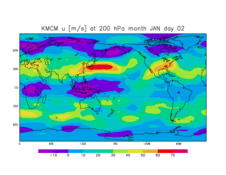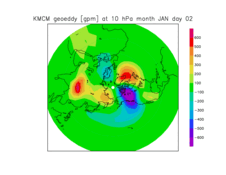KMCM
Kühlungsborn Mechanistic Circulation Model
Description
The development of KMCM started as so-called Simple General Circulation Models (SGCM). The basic numerical schemes are discretization in the vertical direction according to Simmons & Burridge (1981), in the horizontal plane by spherical harmonics (Machenhauer & Rasmussen, 1972) and semi-implicit time stepping (Asselin, 1972; Hoskins & Simmons, 1975). Large-scale orography can be included due to the reference state reformulation of Simmons & Chen (1991). For thermal forcing, a temperature relaxation or a more realistic radiation scheme and a hydrological cycle can be chosen. The models include a boundary layer parameterization and a surface temperature defined with the thermal forcing and response of a slab ocean. Horizontal diffusion is formulated consistently with elementary hydrodynamics (Becker, 2000). Equipped with these dynamic features, KMCM can be used up to an altitude of 130 km (Becker, 2009). In addition, it is equipped with a scale-selective nudging capability (Becker et al., 2022). With these models, no parameterization of inertia-gravity waves is used and there is a unique opportunity to resolve systematically different scales of multi-step vertical coupling processes.
Recent publications
- Avsarkisov, V., B. Strelnikov & E. Becker, 2019: Analysis of the vertical spectra of density fluctuation variance in the strongly stratified turbulence. 11th International Symposium on Turbulence and Shear Flow Phenomena (TSFP11), Southampton, UK, July 30 to August 2, 2019, http://www.tsfp-conference.org/proceedings/2019/96.pdf.
- Avsarkisov, V., E. Becker & T. Renkwitz, 2022: Turbulent Parameters in the Middle Atmosphere: Theoretical Estimates Deduced from a Gravity Wave–Resolving General Circulation Model. J. Atmos. Sci. 79, 4: 933-952, doi:10.1175/jas-d-21-0005.1.
- Becker, E., M. Grygalashvyly & G. R. Sonnemann, 2020: Gravity wave mixing effects on the OH*-layer. Adv. Space Res. 65, 1: 175-188, doi:10.1016/j.asr.2019.09.043.
- Becker, E. & S. L. Vadas, 2020: Explicit Global Simulation of Gravity Waves in the Thermosphere. J. Geophys. Res. Space Physics 125, 10, doi:10.1029/2020ja028034.
- Greer, K. R., S. L. England, E. Becker, D. Rusch & R. Eastes, 2018: Modeled Gravity Wave-Like Perturbations in the Brightness of Far Ultraviolet Emissions for the GOLD Mission. J. Geophys. Res. Space Physics 123: 5821-5830, doi:10.1029/2018JA025501.
- Pokhotelov, D., E. Becker, G. Stober & J. L. Chau, 2018: Seasonal variability of atmospheric tides in the mesosphere and lower thermosphere: meteor radar data and simulations. Ann. Geopys. 36, 3: 825-830, doi:10.5194/angeo-36-825-2018.
- Schaefer-Rolffs, U. & E. Becker, 2018: Scale-Invariant Formulation of Momentum Diffusion for High-Resolution Atmospheric Circulation Models. Mon. Wea. Rev. 146, 4: 1045-1062, doi:10.1175/mwr-d-17-0216.1.
- Vadas, S. L., J. Zhao, X. Chu & E. Becker, 2018: The Excitation of Secondary Gravity Waves From Local Body Forces: Theory and Observation. J. Geophys. Res. Atmos. 123: 9296-9325, doi:10.1029/2017jd027970.
- Vadas, S. L. & E. Becker, 2018: Numerical Modeling of the Excitation, Propagation, and Dissipation of Primary and Secondary Gravity Waves during Wintertime at McMurdo Station in the Antarctic. J. Geophys. Res. Atmos. 123: 9326-9369, doi:10.1029/2017jd027974.
- Vadas, S. L. & E. Becker, 2019: Numerical Modeling of the Generation of Tertiary Gravity Waves in the Mesosphere and Thermosphere During Strong Mountain Wave Events Over the Southern Andes. J. Geophys. Res. Space Physics 124: 7687-7718, doi:10.1029/2019JA026694.
- Zülicke, C., E. Becker, V. Matthias, D. H. W. Peters, H. Schmidt, H.-L. Liu, L. de la Torre Ramos & D. M. Mitchell, 2018: Coupling of stratospheric warmings with mesospheric coolings in observations and simulations. J. Climate 31: 1107-1133, doi:10.1175/JCLI-D-17-0047.1.
Documentation & Code
A complete technical documentation is here: kmcm1r1u10.pdf. The Fortran source code is available on request from Erich Becker.














